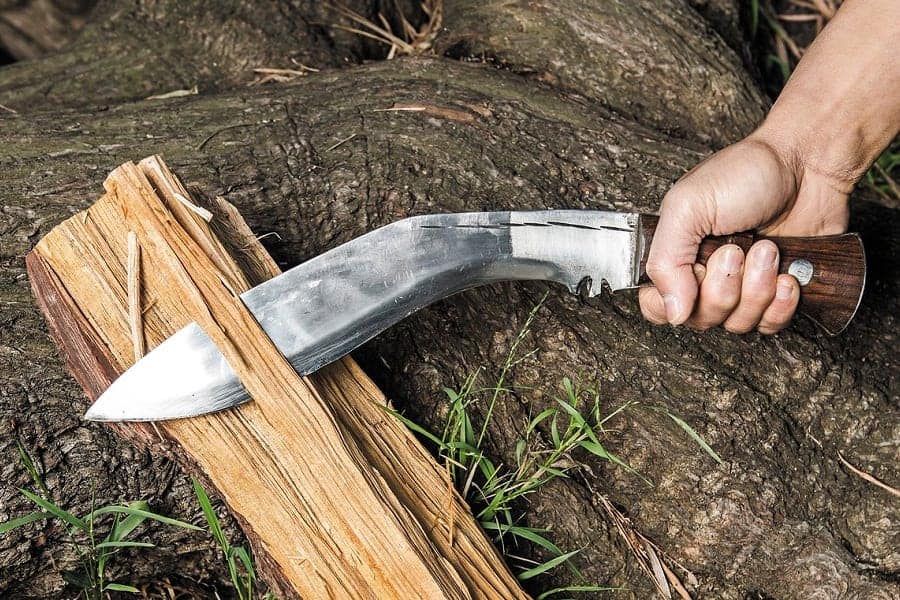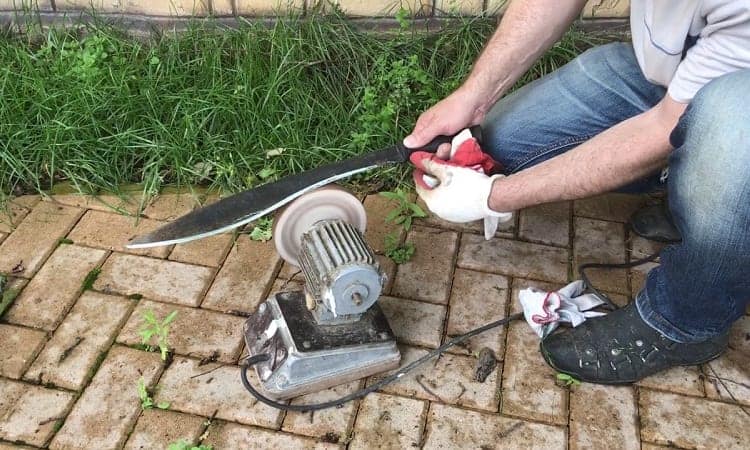If you have been wondering how to sharpen a machete, you are in luck. While this may not be the easiest job in the world, there are only a few steps to the task.
This guide will tell you how to sharpen a machete in two easy steps. We will discuss the different tools you use and what option will be best for beginners.
Furthermore, we will explain why the angle you sharpen at matters and how to choose the right angle.
The article will also cover a few common questions, including why the blades go dull and how machetes are different than other knives.
Let’s get started.
Why Do Machete Blades Go Dull?
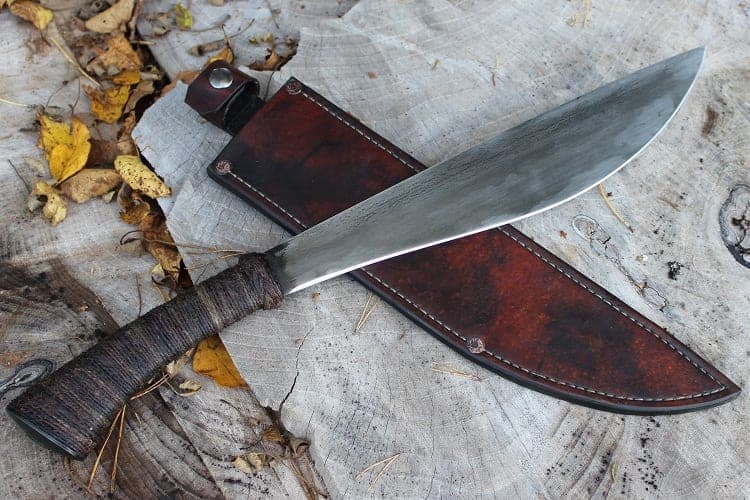
Machete blades go dull because of how people use them. The blade has a lot of different purposes, most of them involving hard-core cutting and chopping.
In many parts of the world, especially in Southeast Asia, machetes’ main jobs are to create trails. The machete can also be used as an ax to cut down trees.
In more modern countries, many hunters and fisherman are starting to use machetes as well.
Here are a few of the main uses for the blade.
For clearing brush
Many land surveyors use machetes to cut down the brush to clear areas for surveying stations.
To create trails
One of the biggest uses of machetes is to create and maintain trails. The sharp blade can easily cut through thick bushes and branches.
For carving wood
Many people use the blade for carving wood. The tool is also great for hacking down tree stumps to promote new growth (called coppicing).
To harvest agriculture
Farmers can also make good use of the machete. The blade can effectively harvest several crops like corn and rye.
For landscaping purposes
Even professional landscapers use the blade. In many landscaping projects, there will be overgrowth, including wood branches and tall grass or plants.
The machete is the perfect tool to trim unnecessary vegetation.
For camping
Yes, people even bring machetes camping. It is an efficient, all-purpose tool for a deep-woods camping trip. Campers will use the knife to chop down wood and maintain their campsite.
A blade can only withstand so much before it experiences some sort of wear and tear.
Since people use machete blades for intensive purposes and extreme cutting action, the blade will inevitably go dull at some point or another.
The other main reason machetes go dull is that they will often hit some metal or hard rock as you use them, which speeds up the dulling process.
What Makes Machetes Different?
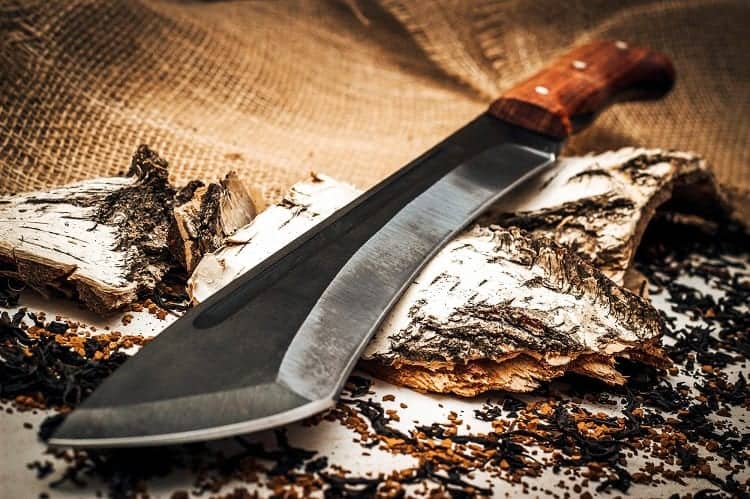
Before we get into answering how to sharpen a machete, let’s dive into the roots of the tool first. Why are machetes so special?
Machetes are not viewed the same as a common kitchen knife. The main factors that make them different from modern tools are their rich history, versatility, potential as tools and build.
History
Historians have traced machete-like tools back to ancient Greece and medieval times. Some of the main tools of these societies greatly resembled the modern machete.
Not only were machetes historical tools, but they were also the primary weapon for many attacks, such as in the 1762 Battle of Havana and in the Rwandan genocide of 1994.
The machete is also a cultural symbol for some countries since it has such a strong presence in its history. Some of these countries include Angola, Columbia, and Venezuela.
Versatility and Potential
The next factor that makes the tool different is its versatility, as proven in the article’s first section.
The tool is used worldwide for a multitude of different purposes. From farmers to fishermen, these workers and hobbyists use the machete to create trails, cut down brush, maintain campsites, and several other jobs.
There are not a lot of tools out there with this kind of versatility.
Not only is it versatile, but it has potential. In other words, there is not a limited list of the jobs you can do with a machete.
People can use the tool as a knife, an ax, or even a sword (hopefully, you won’t need to use it as the last option).
The Build
Part of what gives the tool its strength is its build. The machete has a broad blade that can vary in length from 10 to 24 inches.
Many blades will be curved, but you can also buy a machete with a straight blade, depending on the intended use of the tool.
Manufacturers normally use carbon steel for the blade. Finally, the tool has three different parts: the blade, the handle, and the sheath.
Step-by-Step Guide for Sharpening a Machete
Now that we have covered why machete blades go dull and what makes them different let’s find out how to sharpen a machete. There are a few different ways to do this.
Step One: Choose Your Sharpening Instrument
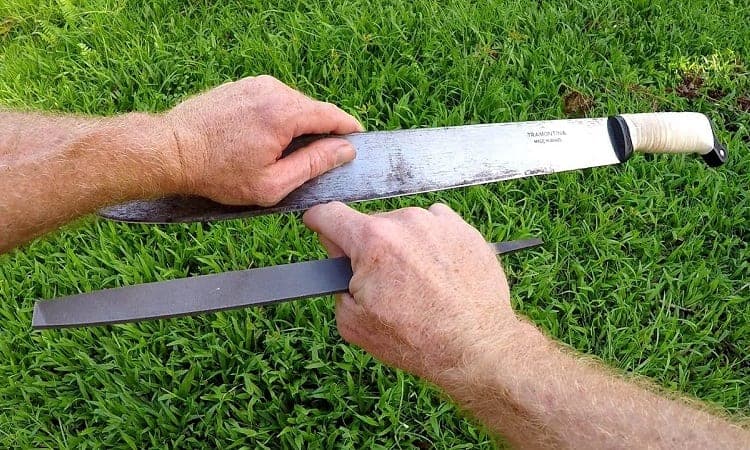
There are a few different sharpening tools to choose from, each with its own perks. Let’s look at the most popular instruments.
The belt sander
If you are a beginner to the whole process, we highly recommend using the belt sander. Belt sanders are easy to use and relatively inexpensive.
It is very easy to maintain the control of pressure with this tool, and you won’t have a problem keeping the blade straight on the belt.
A mill file
This tool will be another cheaper option. When using a mill file, make sure to stabilize your blade with a vise. Then you will take the mill file and push it over the blade.
You will repeat this step until you sharpen it to your liking (you will need to turn the blade over and do the other side).
Mill files are also great for beginners since it will be hard for you to damage the blade.
Grinding wheels
We only recommend grinding wheels if you are more experienced in sharpening blades. This tool is very intense and has the potential to damage your machete if you aren’t careful.
What you have to do with a grinding wheel is to draw your machete over the wheel in one smooth motion, making sure you cover the blade’s entire length.
Step Two: Find the Right Angle
When you are wondering how to sharpen a machete, you not only have to know what tool to use but also what angle to sharpen the blade at.
The angle you sharpen the blade at can affect the performance of the machete. For instance, if you sharpen the blade to be thin, it will cut better, but it will be less durable.
On the other hand, if you don’t sharpen the blade as much, it will be more durable but won’t cut as well.
It all depends on how you want to use the knife. There are a few basic guidelines to follow when choosing the right angle.
- Avoid sharpening at a 20-degree angle: This angle (20-degree inclusive angle, 10 on each side) will produce a very fragile blade that will not last long in the bush.
- Sharpen at a 25-30 degree inclusive angle for grass and soft vegetation: An angle around 30 (15 degrees per side) will still be fragile but will perform well with vegetation and grass. If you simply want to trim some plants, this angle will be good.
- Sharpening at a 40-60 degree inclusive angle will give the best overall performance: Sharpen at 20-30 degrees per blade side to get the best of both worlds. You can use a machete sharpened at this angle for cutting wood, grass, and anything in between.
Extra Tips
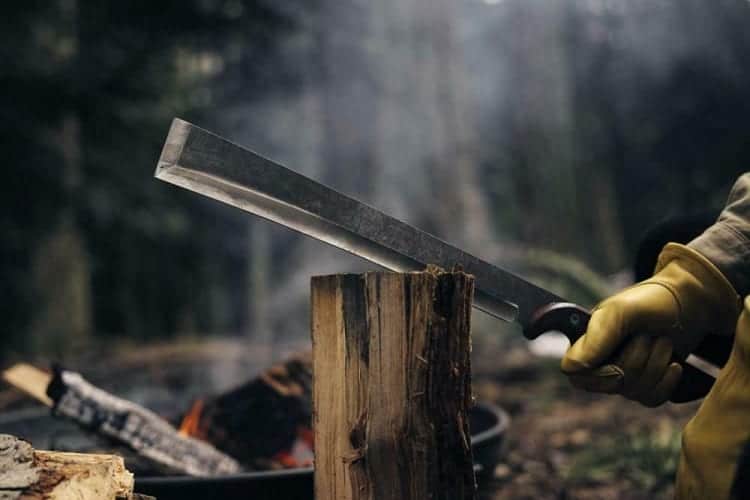
Now you know how to sharpen a machete. However, there are a few extra tips to keep in mind before jumping the gun.
Stay safe
Machetes are dangerous knives and should not be dealt with lightly. When you are sharpening the brutal tool, make sure to stay safe.
The first thing you can do is wear protective gloves to avoid any deep cuts. You can also sharpen with the blade facing away from you to be more cautious.
Be mindful of the blade’s temperature
With some sharpening instruments like belt sanders or grinding wheels, the blades can become very hot.
While sharpening, make sure to keep an eye on the temperature. You can easily damage the blade if it gets too hot.
Dump cold water on the blade to keep the temperature down
If you find that the blade is getting too hot during the sharpening process, you can pour cool water on the metal to cool it down.
Watch out for burrs when sharpening
When using a mill file especially, you will need to make sure no burrs appear. Burrs are small, raised bumps on the opposite side of the blade you are sharpening.
File them down to create a smooth finish and sharp edge.
Conclusion
We hope that this guide made the process of sharpening machetes a bit easier.
Before you sharpen a machete, you will need to know what kind of sharpening tool you will be using.
If you are a beginner to the process, we recommend using a belt sander or a mill file. Both of these options are relatively cheap and easy to use.
Furthermore, it will be hard to damage your blade using these two tools, making them great for beginners.
However, for those of you with prior experience, grinding wheels are another option. This tool has more firepower and will be ideal for the initial sharpening of the blade.
Resources:

